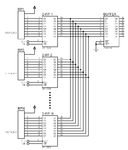Prakash12345
Junior Member level 2
How to increase fanout of CMOS buffer
Hi,
I'm new to online forum. I want to interface 74HC541(Buffer) to 74HC574(D-f/f). The thing is 100's of D-f/f parallel interface as shown in figure(Fig.1).
Input and load capacitance limits it to 10 to 15 fanout. Fanout of buffer current wants to charge input capacitance of D-f/f. So increasing D-f/f increases charge time of input capacitance.
My question is this can be overcome by giving more current to increase charge current to input capacitance by adding pullup resistor to input of D-f/f(Fig.2) or BJT emitter follower(Fig.3).
This would correct or not.
Hi,
I'm new to online forum. I want to interface 74HC541(Buffer) to 74HC574(D-f/f). The thing is 100's of D-f/f parallel interface as shown in figure(Fig.1).
Input and load capacitance limits it to 10 to 15 fanout. Fanout of buffer current wants to charge input capacitance of D-f/f. So increasing D-f/f increases charge time of input capacitance.
My question is this can be overcome by giving more current to increase charge current to input capacitance by adding pullup resistor to input of D-f/f(Fig.2) or BJT emitter follower(Fig.3).
This would correct or not.

